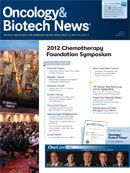Publication
Article
Study Results May Change Treatment Standard for Patients Receiving Transplants From Unrelated Donors
Author(s):
Patients receiving transplants from unrelated donors to treat various hematologic malignancies may benefit more from receiving adult stem cells harvested from bone marrow rather than peripheral-blood stem cells (the current standard).
Claudio Anasetti, MD
Patients receiving transplants from unrelated donors to treat various hematologic malignancies may benefit more from receiving adult stem cells harvested from bone marrow rather than peripheral-blood stem cells (the current standard). It seems bone marrow transplantation offers similar survival benefits while reducing the risk of developing graft-versus-host disease (GVHD), according to the results of a phase III study published in The New England Journal of Medicine.
Numerous large, randomized trials have shown that transplantation of peripheral-blood stem cells between human leukocyte antigen (HLA)—identical siblings resulted in better engraftment, but the risk of developing GVHD also increased. While some studies showed longer survival and a decreased risk of relapse, these results may not apply to patients who receive donor cells from unrelated donors. Peripheral-blood stem cells have been increasingly used in transplants, but higher rates of GVHD have been observed in these patients compared with those who receive transplantations from bone marrow. This randomized trial, led by Claudio Anasetti, MD, H. Lee Moffitt Cancer, Tampa, Florida, was designed to compare the outcomes between the two sources of donor cells.
In the study, 551 patients across 48 centers were randomly assigned 1:1 to receive either peripheral-blood stem-cell (n = 273) or bone marrow (n = 278) transplantation. The patients had been diagnosed with a variety of hematologic malignancies at various stages, including acute myeloid leukemia, acute lymphoblastic leukemia, chronic myeloid leukemia, and others. Surviving patients were followed for a median of 36 months.
At 2 years, the incidence of chronic GVHD in the peripheral-blood group was 53% (95% CI, 45-61), compared with 41% (95% CI, 34-48) in the bone marrow group (P = .01). The rate of graft failure was 3% (95% CI, 1-5) in the peripheral-blood group versus 9% (95% CI, 6-13) in the bone marrow group (P = .002). The overall survival rate in the peripheral-blood group was 51% (95% CI, 45-57), compared with 46% (95% CI, 40-52) in the bone marrow group, although this difference was not statistically significant (P = .29).1
Frederick R. Appelbaum, MD
In an accompanying editorial, Frederick R. Appelbaum, MD, member and director of the Clinical Research Division at the Fred Hutchinson Cancer Research Center in Seattle, Washington, and executive director of the Seattle Cancer Care Alliance, wrote that while the study had its shortcomings—including the small size of the study, limited duration of follow-up, and a lack of quality-of-life data—he believes the outcome should influence the way these transplants are handled.2
“The results provide data that should change current practice. Instead of being the default choice for most unrelated-donor transplants, mobilized peripheral-blood stem cells should be used in only the minority of patients for whom the benefits outweigh the risks,” Appelbaum wrote. “For the majority of unrelated-donor transplantations performed after the patient has undergone a standard, high-dose preparative regimen, bone marrow should be used.”
Appelbaum also wrote that the outcomes of hematopoietic stem cell transplantation with either bone marrow or peripheral blood from unrelated donors are now similar to those seen in related-donor transplantations, thanks to improvements in HLA typing, preparative regimens, and supportive care.
- Anasetti C, Logan BR, Lee SJ, et al. Peripheral-blood stem cells versus bone marrow from unrelated donors. N Engl J Med. 2012;367(16):1487-1496.
- Appelbaum, FR. Pursuing the goal of a donor for everyone in need. N Engl J Med. 2012;367(16):1555-1556.

Latest Conference Coverage

Experts Highlight Noteworthy Research From the 2024 ESMO Congress

MR-Linac Radiotherapy Limits Target Volume, Brain Tissue Exposure in High-Grade Glioma

PFS Data for 177Lu-Dotatate Surpass Clinical Benchmarks in Refractory Meningioma

Nivolumab Plus Radiotherapy Reduces Rates of Biochemical Recurrence in Gleason Grade 5 Prostate Cancer
2 Commerce Drive
Cranbury, NJ 08512





